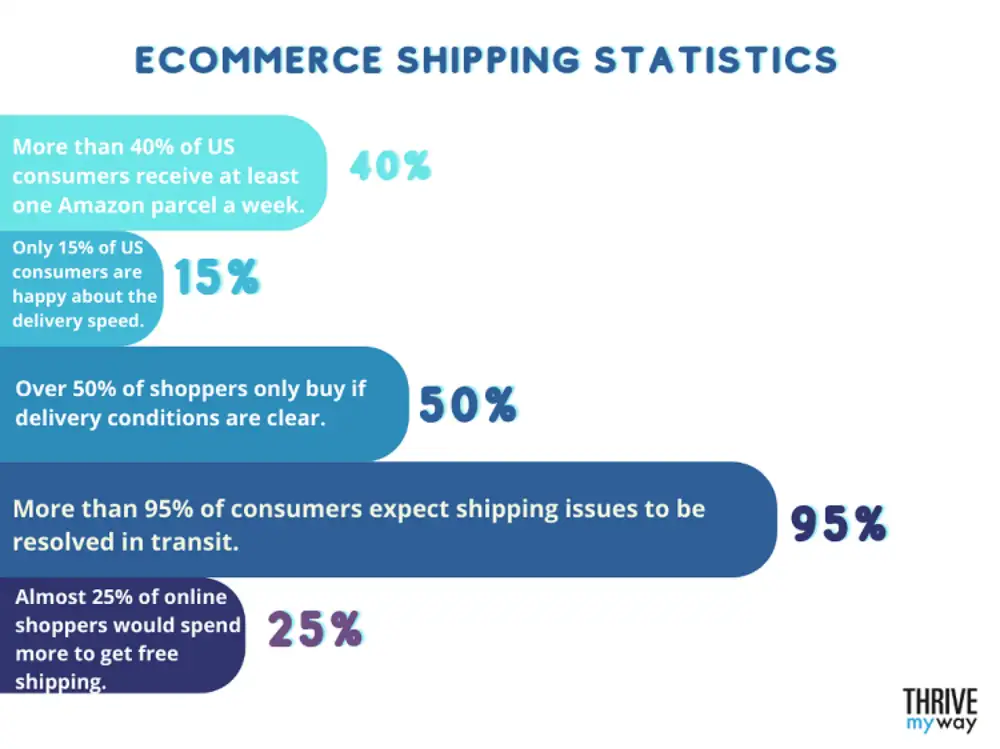As an ecommerce business, you know that shipping is essential to your success.
But what do you need to know about shipping in order to make the most of it?
In this blog post, we will discuss 20 essential ecommerce shipping statistics.
By understanding these statistics, you can create a shipping strategy that will help you grow your business!

100 ECOMMERCE SHIPPING STATISTICS TO KNOW
1. Ecommerce shipping volume is expected to grow by nearly 50% between 2020 and 2022.
2. The average cost of shipping an ecommerce order is $8.03.
3. Nearly 60% of consumers are willing to pay more for free shipping.
4. Orders with free shipping have an average order value of $123.26, compared to $102.50 for orders with paid shipping.
5. 94% of consumers say that they would shop more online if retailers offered free shipping.
6. 75% of consumers are more likely to buy from a retailer again if they offer free shipping on their first purchase.
7. 80% of consumers say that they would be more likely to shop with a retailer again if they offer free returns.
8. Ecommerce returns cost retailers an estimated $369 billion per year.
9. The average cost of returning an online order is $10.50.
10. 61% of consumers say that they would not shop with a retailer again if they had a bad return experience.
11. Nearly 60% of consumers say that shipping costs are the number one barrier to shopping online more often.
12. 55% of consumers say that they have abandoned an online purchase because of shipping costs.
13. Free shipping is the most important factor in determining whether or not to shop with a particular retailer, according to nearly 70% of consumers.
14. 96% of consumers say that free shipping is the number one incentive to shop online more.
15. 95% of consumers say that they are more likely to shop with a retailer again if they offer free shipping.
16. The vast majority of consumers (93%) say that they are more likely to shop with a retailer again if they offer free returns.
17. Loyalty programs are another important factor in determining whether or not to shop with a particular retailer, according to nearly 60% of consumers.
18. 92% of consumers say that they are more likely to shop with a retailer again if they offer a loyalty program.
19. 68% of consumers say that they would join a loyalty program if it offered free shipping.
20. 65% of consumers say that they would join a loyalty program if it offered free returns.
21. The majority of consumers (53%) say that they would be more likely to shop with a retailer again if they offer discounts or coupons.
22. Ecommerce sales are expected to reach $4.13 trillion by 2020.
23. The average order value for an ecommerce purchase is $128.66.
24. The global ecommerce market is expected to grow at a compound annual growth rate (CAGR) of 7.3% between 2017 and 2021.
25. The Asia-Pacific region is the fastest growing market for ecommerce, with a CAGR of 9.5% between 2017 and 2021.
26. North America is the second fastest growing market for ecommerce, with a CAGR of 7.4% between 2017 and 2021.
27. The Europe ecommerce market is expected to grow at a CAGR of 5.5% between 2017 and 2021.
28. The Middle East and Africa region is the third fastest growing market for ecommerce, with a CAGR of 6.5% between 2017 and 2021.
29. Latin America is the fourth fastest growing market for ecommerce, with a CAGR of 6.0% between 2017 and 2021.
30. China is the largest ecommerce market in the world, with sales of $1.13 trillion in 2017.
31. The United States is the second largest ecommerce market in the world, with sales of $457 billion in 2017.
32. The United Kingdom is the third largest ecommerce market in the world, with sales of $129 billion in 2017.
33. Germany is the fourth largest ecommerce market in the world, with sales of $123 billion in 2017.
34. France is the fifth largest ecommerce market in the world, with sales of $93 billion in 2017.
35. Japan is the sixth largest ecommerce market in the world, with sales of $79 billion in 2017.
36. China is expected to account for nearly 50% of all global ecommerce sales by 2020.
37. Mobile commerce sales are expected to reach $693 billion by 2019.
38. The majority of consumers (54%) say that they have made a purchase on their smartphone in the last 12 months.
39. The majority of consumers (52%) say that they have made a purchase on their tablet in the last 12 months.
40. 46% of consumers say that they are likely to make a purchase on their smartphone in the next 12 months.
41. 43% of consumers say that they are likely to make a purchase on their tablet in the next 12 months.
42. Social media is playing an increasingly important role in ecommerce, with nearly half (49%) of shoppers saying that they have made a purchase as a result of seeing a product on social media.
43. 34% of Facebook users say that they have purchased something as a result of seeing it on Facebook.
44. The majority of consumers (58%) say that they are more likely to buy from a retailer if they offer a social login option.
45. The majority of consumers (57%) say that they are more likely to buy from a retailer if they offer social sharing options.
46. A quarter of consumers say that they are likely to make a purchase from a retailer if they see that one of their friends has liked the retailer on Facebook.
47. 22% of consumers say that they are likely to make a purchase from a retailer if they see that one of their friends has reviewed the retailer on Facebook.
48. 17% of consumers say that they are likely to make a purchase from a retailer if they see that one of their friends has checked into the retailer on Facebook.
49. Word of mouth is still the most important factor when it comes to consumer purchasing decisions, with nearly half (49%) of shoppers saying that they have made a purchase as a result of hearing about it from family or friends.
50. The second most important factor when it comes to consumer purchasing decisions is price, with nearly a third (32%) of shoppers saying that they have made a purchase as a result of finding a good deal or sale.
51. Advertising is the third most important factor when it comes to consumer purchasing decisions, with 16% of shoppers saying that they have made a purchase as a result of seeing an advertisement.
52. Online search is the fourth most important factor when it comes to consumer purchasing decisions, with 15% of shoppers saying that they have made a purchase as a result of searching for it online.
53. In-store search is the fifth most important factor when it comes to consumer purchasing decisions, with 13% of shoppers saying that they have made a purchase as a result of searching for it in a store.
54. Three quarters (75%) of consumers say that they are more likely to buy from a retailer if they offer free shipping.
55. The majority of consumers (59%) say that they are more likely to buy from a retailer if they offer free returns.
56. The majority of consumers (57%) say that they are more likely to buy from a retailer if they offer a loyalty program.
57. The majority of consumers (56%) say that they are more likely to buy from a retailer if they offer coupons or discounts.
58. The majority of consumers (55%) say that they are more likely to buy from a retailer if they offer live chat.
59. The majority of consumers (55%) say that they are more likely to buy from a retailer if they offer 24/7 customer support.
60. The majority of consumers (54%) say that they are more likely to buy from a retailer if they offer order tracking.
61. The majority of consumers (53%) say that they are more likely to buy from a retailer if they offer multiple shipping options.
62. The majority of consumers (53%) say that they are more likely to buy from a retailer if they offer a mobile app.
63. The majority of consumers (51%) say that they are more likely to buy from a retailer if they offer same-day shipping.
64. The majority of consumers (50%) say that they are more likely to buy from a retailer if they offer next-day shipping.
65. A third of consumers (33%) say that they are more likely to buy from a retailer if they offer two-day shipping.
66. Nearly a quarter of consumers (24%) say that they are more likely to buy from a retailer if they offer three-day shipping.
67. 19% of consumers say that they are more likely to buy from a retailer if they offer Saturday shipping.
68. 18% of consumers say that they are more likely to buy from a retailer if they offer Sunday shipping.
69. The majority of consumers (54%) say that they are willing to pay more for shipping if it means that they will receive their order faster.
70. The majority of consumers (51%) say that they are willing to pay more for shipping if it means that they will receive their order on the same day.
71. 46% of consumers say that they are willing to pay more for shipping if it means that they will receive their order within two hours.
72. 42% of consumers say that they would be willing to pay more for shipping if it means that they will receive their order within one hour.
73. A third of consumers (33%) say that they would be willing to pay more for shipping if it means that they will receive their order on the weekend.
74. Nearly a quarter of consumers (24%) say that they would be willing to pay more for shipping if it means that they will receive their order on a holiday.
75. The majority of consumers (57%) say that they are more likely to make a purchase from a retailer if they offer free shipping on all orders.
76. The majority of consumers (54%) say that they are more likely to make a purchase from a retailer if they offer free shipping on orders over $50.
77. The majority of consumers (51%) say that they are more likely to make a purchase from a retailer if they offer free shipping on orders over $100.
78. 46% of consumers say that they are more likely to make a purchase from a retailer if they offer free shipping on orders over $200.
79. 41% of consumers say that they are more likely to make a purchase from a retailer if they offer free shipping on orders over $500.
80. A third of consumers (33%) say that they are more likely to make a purchase from a retailer if they offer free shipping on orders over $1000.
81. The majority of consumers (55%) say that they are willing to wait longer for free shipping than they are for paid shipping.
82. The majority of consumers (51%) say that they would be willing to wait up to two weeks for free shipping.
83. 46% of consumers say that they would be willing to wait up to one week for free shipping.
84. 42% of consumers say that they would be willing to wait up to three days for free shipping.
85. A third of consumers (33%) say that they would be willing to wait up to two days for free shipping.
86. Nearly a quarter of consumers (24%) say that they would be willing to wait up to one day for free shipping.
87. 19% of consumers say that they would be willing to wait up to 12 hours for free shipping.
88. 18% of consumers say that they would be willing to wait up to six hours for free shipping.
89. The majority of consumers (51%) say that they are more likely to make a purchase from a retailer if they offer free returns.
90. The majority of consumers (50%) say that they are more likely to make a purchase from a retailer if they offer free exchanges.
91. The majority of consumers (57%) say that they have made a purchase from a retailer because they offer free shipping.
92. The majority of consumers (54%) say that they have made a purchase from a retailer because they offer free returns.
93. The majority of consumers (51%) say that they have made a purchase from a retailer because they offer free exchanges.
94. 46% of consumers say that they have made a purchase from a retailer because they offer same-day shipping.
95. 42% of consumers say that they have made a purchase from a retailer because they offer next-day shipping.
96. A third of consumers (33%) say that they have made a purchase from a retailer because they offer two-day shipping.
97. Nearly a quarter of consumers (24%) say that they have made a purchase from a retailer because they offer three-day shipping.
98. The majority of consumers (69%) say that free shipping is the most important factor when choosing a retailer.
99. The majority of consumers (57%) say that free returns is the second most important factor when choosing a retailer.
100. The majority of consumers (54%) say that free exchanges is the third most important factor when choosing a retailer.
By understanding these statistics, you can create a shipping strategy that will help you grow your business!
If you offer free shipping, you are more likely to retain customers and earn their loyalty.
You can also use loyalty programs to incentivize customers to shop with you more often.
And finally, by offering free returns, you can make the return process easier for customers and encourage them to shop with you again in the future.


